Rocket Lake Rumble: Three Mini-ITX Z590 Motherboards Battle for Compact Supremacy
Three Z590 based Mini-ITX boards go head to head for your Rocket Lake build dollars
As of March 2021, we’ve updated our test system to Windows 10 64-bit OS (20H2) with all threat mitigations applied. On the hardware front, we’ve switched to all PCIe 4.0 components. We upgraded our video card to an Asus RTX 3070 TUF Gaming and the storage device to a 2TB Phison PS5-18-E18 M.2. Along with the hardware changes, we’ve also updated the games to F1 2020 and Far Cry: New Dawn. We use the latest non-beta motherboard BIOS available to the public unless otherwise noted (typically during new platform launches). The hardware used is as follows:
Test System Components
| CPU | Intel i9-11900K |
| RAM | GSkill Trident Z Neo 2x8GB DDR4 3600 (F4-3600C16Q-32GTZN) |
| Row 2 - Cell 0 | GSkill Trident Z Royale 2x8GB DDR4 4000 (F4-4000C18Q-32GTRS) |
| GPU | Asus TUF Gaming RTX 3070 |
| CPU Cooling | Corsair H150i |
| PSU | Corsair AX1200i |
| Software | Windows 10 64-bit 20H2 |
| Graphics Driver | NVIDIA Driver 461.40 |
| Sound | Integrated HD audio |
| Network | Integrated Networking (GbE or 2.5 GbE) |
Benchmark Settings
| Synthetic Benchmarks and Settings | Row 0 - Cell 1 |
| PCMark 10 | Version 2.1.2508 64 |
| Row 2 - Cell 0 | Essentials, Productivity, Digital Content Creation, MS Office |
| 3DMark | Version 2.17.7137 64 |
| Row 4 - Cell 0 | Firestrike Extreme and Time Spy Default Presets |
| Cinebench R20 | Version RBBENCHMARK271150 |
| Row 6 - Cell 0 | Open GL Benchmark - Single and Multi-threaded |
| Application Tests and Settings | Row 7 - Cell 1 |
| LAME MP3 | Version SSE2_2019 |
| Row 9 - Cell 0 | Mixed 271MB WAV to mp3: Command: -b 160 --nores (160Kb/s) |
| HandBrake CLI | Version: 1.2.2 |
| Row 11 - Cell 0 | Sintel Open Movie Project: 4.19GB 4K mkv to x264 (light AVX) and x265 (heavy AVX) |
| Corona 1.4 | Version 1.4 |
| Row 13 - Cell 0 | Custom benchmark |
| 7-Zip | Version 19.00 |
| Row 15 - Cell 0 | Integrated benchmark |
| Game Tests and Settings | Row 16 - Cell 1 |
| F1 2020 | Ultra Preset - 1920 x 1080, TAA, 16xAF (Australia, Clear, Dry) |
| Far Cry: New Dawn | Ultra Preset - 1920 x 1080 |
Benchmark Results
Our standard benchmarks and power tests are performed using the CPU’s stock frequencies (including stock Thermal Velocity Boost), with all power-saving features enabled. Optimized defaults are set in the BIOS and the memory set using the XMP profiles. For this baseline testing, Windows is set to the balanced power plan.
Synthetic Benchmarks
Synthetics are a great tool to figure out if a board runs out of spec, as identical settings should produce similar performance results. Advanced memory timings are the one place where motherboard makers can still optimize for either stability or performance, though, and those settings can impact some testing.







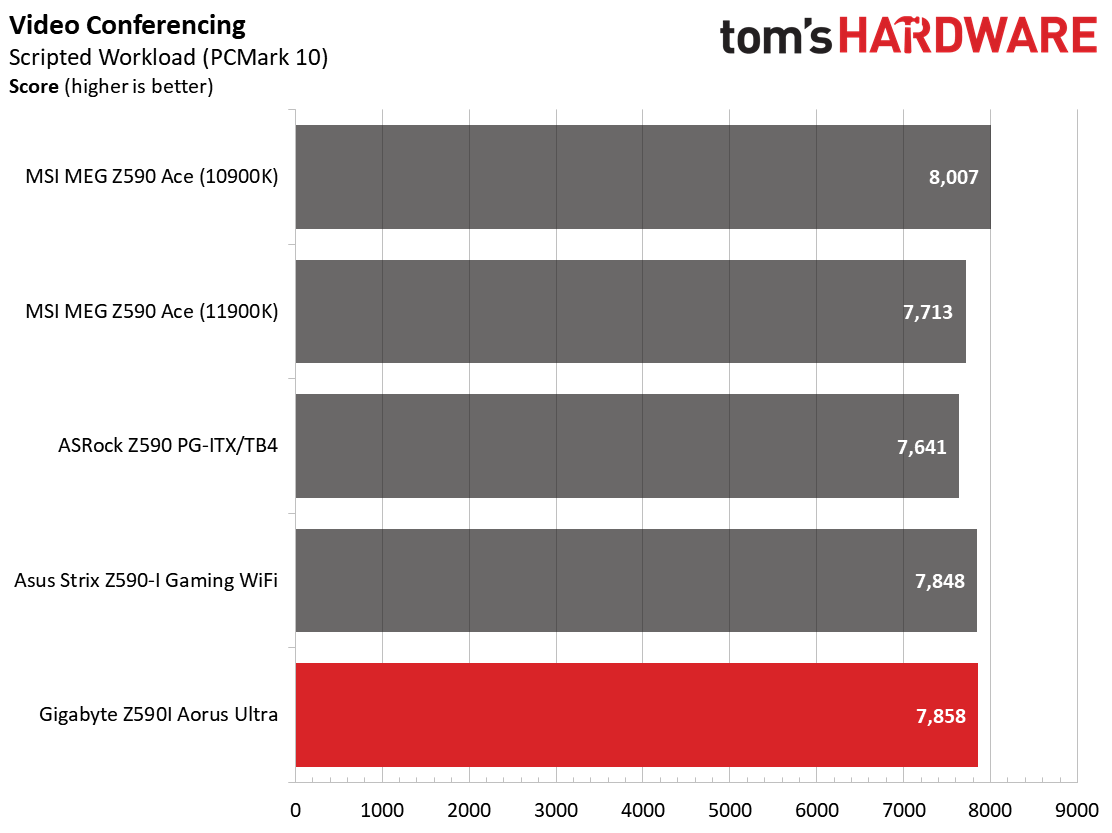




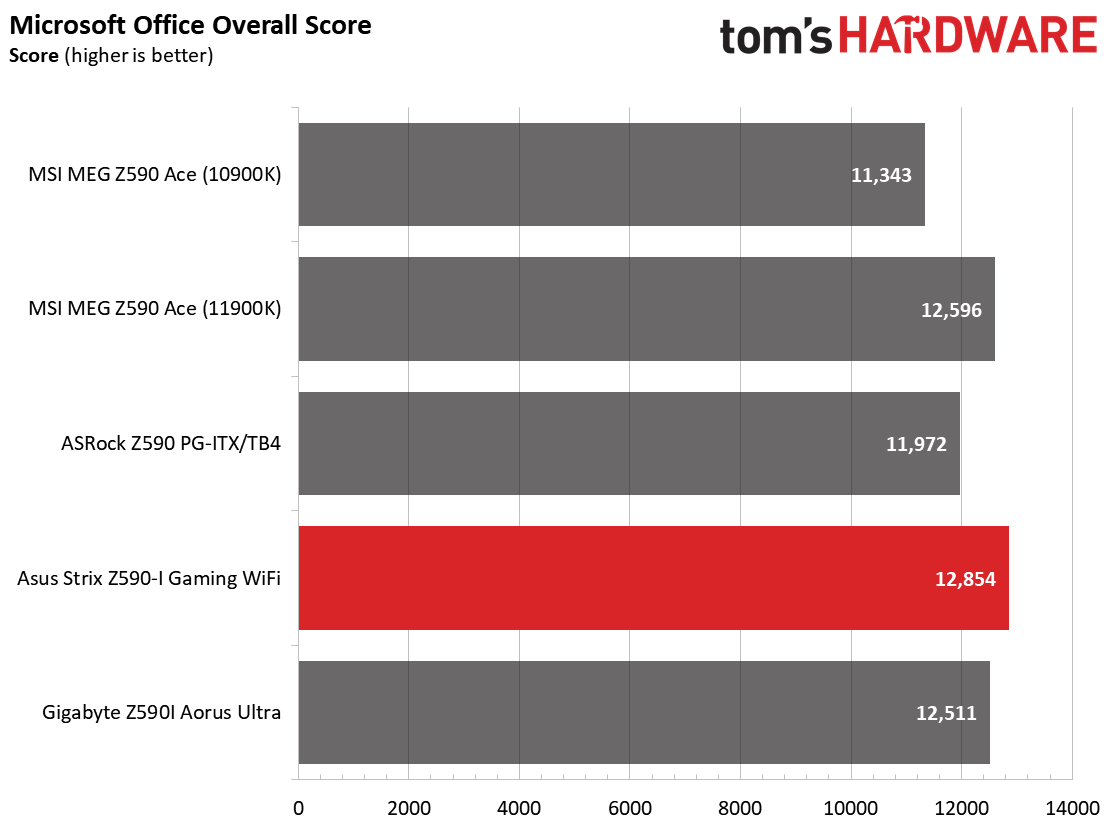
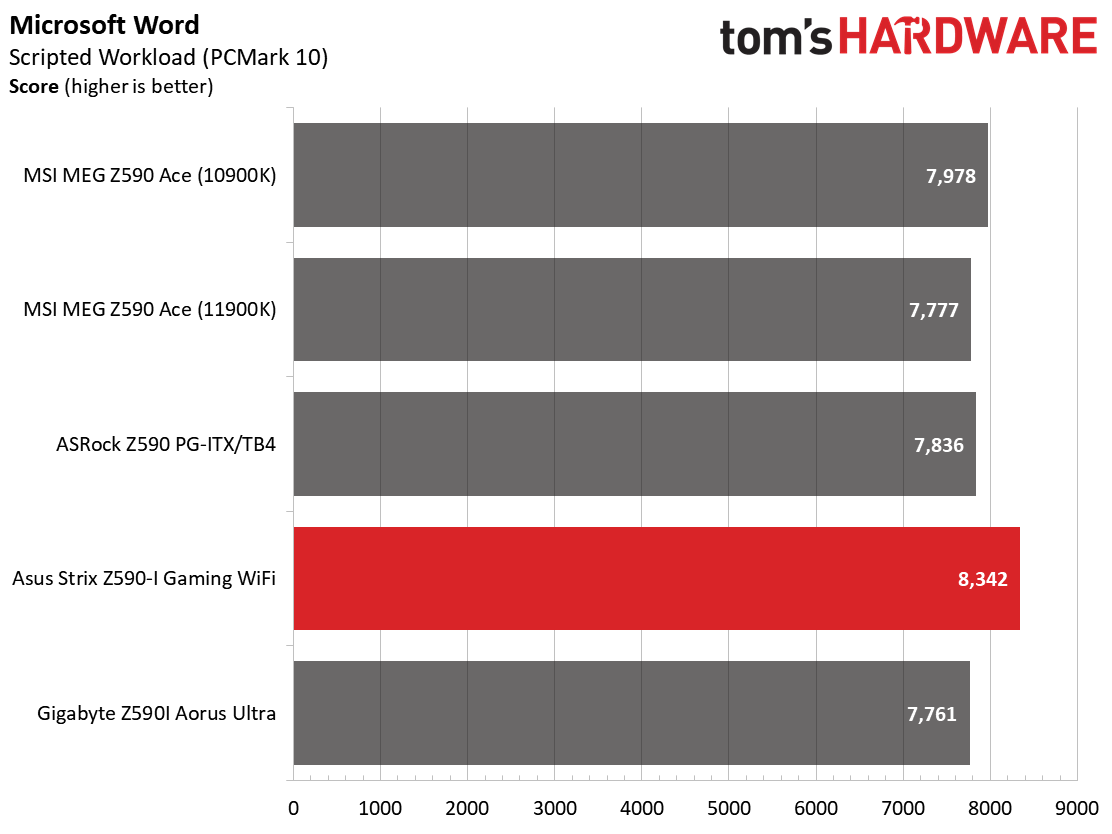


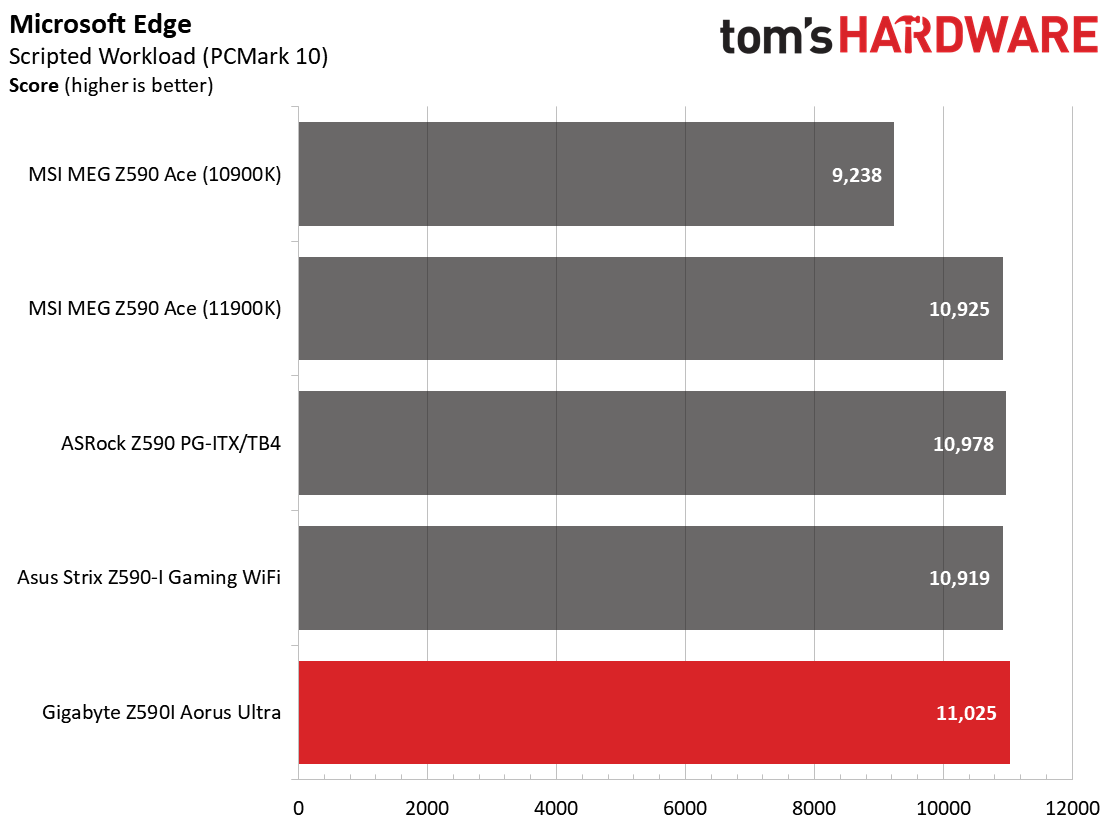



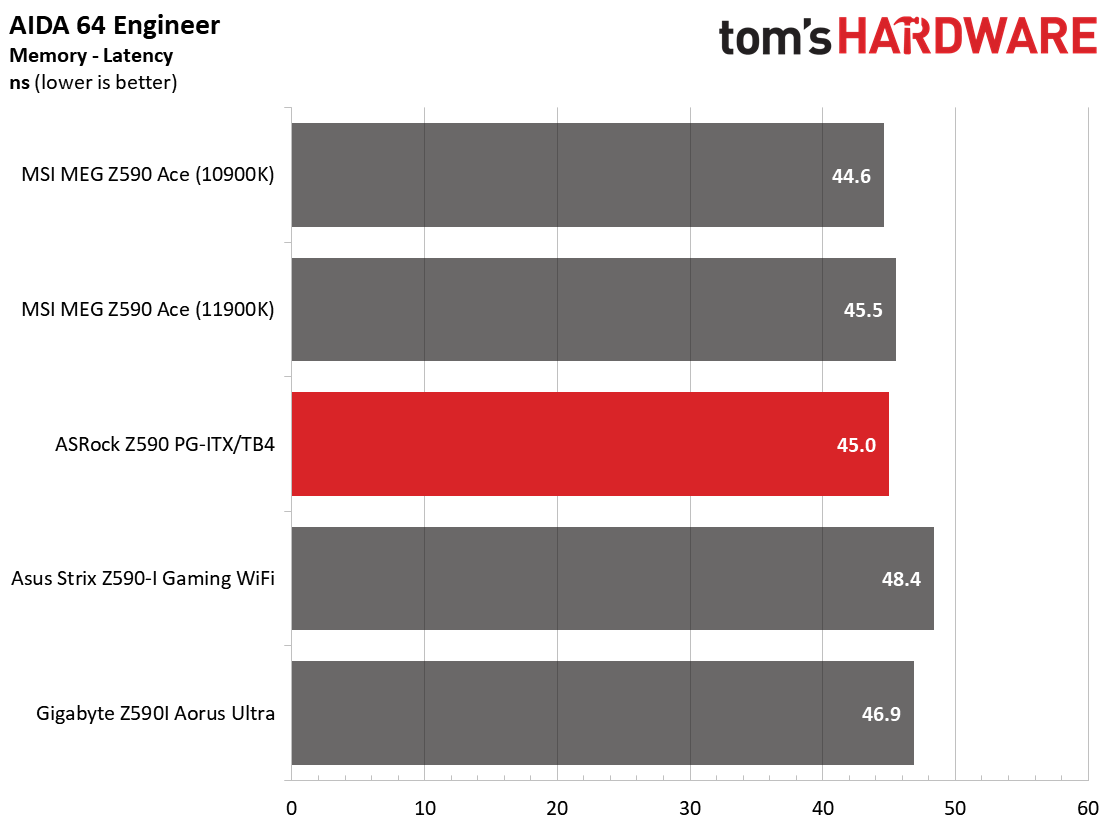
As we look at the synthetic benchmarks, our trio of boards performed well overall compared to their full-size counterparts. Among the three boards we’re testing in this feature, we found the ASRock ITX/TB4 sticks to the Intel specification while at stock speeds, where the others do not. In any long-running tests, this board generally comes up a bit slower than rest. That said, all you need to do is raise the PL1/PL2 limits in the BIOS and the ASRock ITX board performs just as well as the others.
Timed Applications


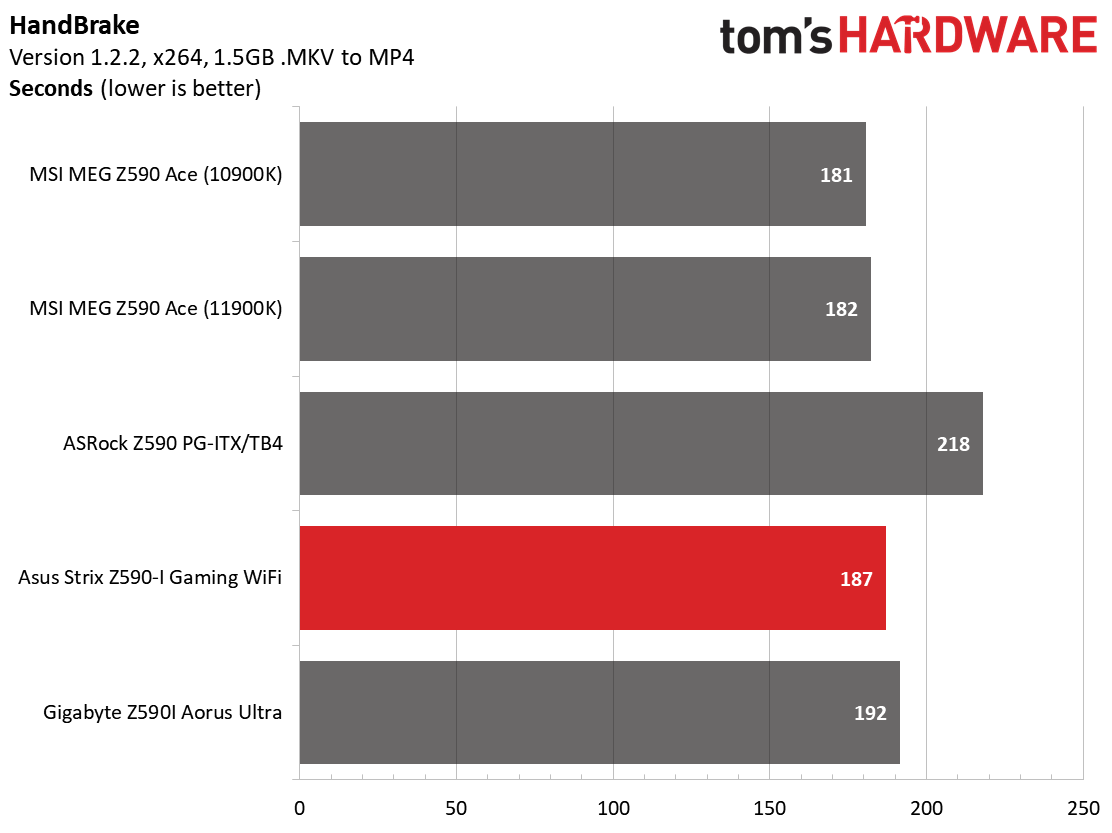

In our timed applications, LAME testing results were all close, with the Asus and Giga running this benchmark at 11.48 seconds while the ASRock was negligibly behind at 11.51 seconds. Corona testing has the Gigabyte Aorus Ultra beating the rest of the board with an 81-second run. The Asus followed with 85 seconds and the ASRock was last at 87 seconds. The latter two times do sit in the lower end of results compared to other Rocket Lake boards we’ve tested.
3D Games and 3DMark




We’ve recently updated our game tests to F1 2020 and Far Cry: New Dawn. The games are run at 1920x1080 resolution using the Ultra preset. As the resolution goes up, the CPU tends to have less of an impact. The goal with these settings is to determine if there are differences in performance at the most commonly used resolution with settings most people use or at least strive for.
In looking at our gaming benchmarks, all of our Mini-ITX boards did OK. The synthetic scores and real game data matched or exceeded the full-size competition. The Gigabyte was technically the fastest, however it only showed its mettle during Far Cry: New Dawn. There is very little difference between these boards when it comes to gaming prowess.
Get Tom's Hardware's best news and in-depth reviews, straight to your inbox.
Power Consumption / VRM Temperatures

We used AIDA64’s System Stability Test with Stress CPU, FPU and Cache enabled for power testing, using the peak power consumption value. With Rocket Lake, we need to disable AVX-512 instruction sets; otherwise, temperatures are out of control at stock speeds on some boards. The wattage reading is from the wall via a Kill-A-Watt meter to capture the entire ecosystem. The only variable that changes is the motherboard; all other parts are the same.
Surprisingly to me, all three boards tend to use as much or more power than the larger pool of full-sized boards tested. The Gigabyte used the least among the three, averaging 163W, with the ASRock using 178W and the Asus averaging 183W. The ASRock and Asus were on the high side, while the Gigabyte board was closer to the running average of all tested motherboards.




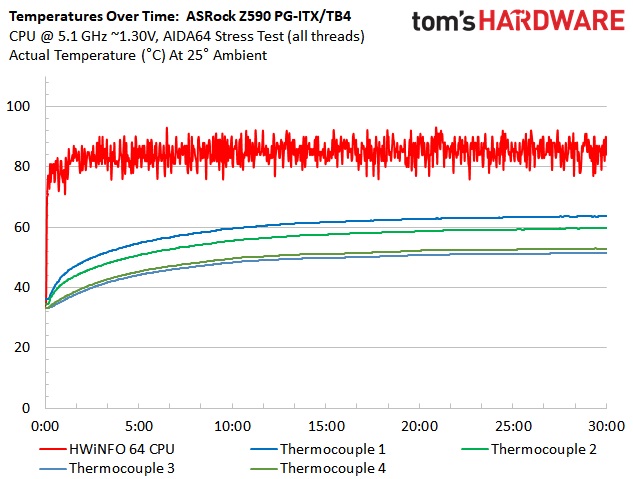



During stock operation, all three boards handled the flagship Intel Core i9-11900K without issue. The Asus board ran the warmest, approaching 56 degrees Celsius, with the Gigabyte peaking around 54 degrees Celsius and the ASRock running the coolest reaching 52 degrees Celsius. A primary reason ASRock ran the coolest is due to having the most restrictions--remember it runs with Intel specifications out ofhte box-- and using active cooling. Where most ran this test at 4.8 GHz, the ASRock dropped down after the Turbo Boost time was spent.
Once we lift all of the restrictions on these boards and overclock them, the story changes a bit. In this situation, both the Asus and Gigabyte peak just over 61 degrees Celsius while the ASRock ran the warmest here, peaking around 64 degrees Celsius. These temperatures are expected, and none of these tiny boards ran into problems overclocking with ambient cooling.
Overclocking
Overclocking on all of these boards was easy. Outside of minor BIOS quirks, it was a straightforward experience. It was a matter of raising the CPU multiplier, Vcore, disabling/raising any power/current limits and any Adaptive Boost technologies that get in the way. We saw above that VRM temperatures are in order on an open-air test bench, so your only concern is making sure your presumably small chassis has adequate airflow for all of the internals. Today’s modern processors and video cards, kick out quite a bit of heat--especially when overclocked. In the end, all boards reached our 5.1 GHz target and didn’t melt anything in the process. Just be sure to bring some fans.
When overclocking the i9-11900K, we decided to do so by testing without AVX-512 instructions. When you unlock all of the power limits, you’re thermally limited, with the CPU reaching 100 degrees Celsius in several seconds. Since every board is different in terms of following (or not following) Intel specifications, we’ve removed that variable. The bottom line is that if you need to use these instructions, you’ll need to set a significant offset compared to non-AVX-512 loads. To that end, we settled on a 5.1 GHz overclock at around 1.3V. Our CPU uses around 225W in this configuration, which lands between stock power use (195W) and AVX-512 power use (~265W) and is the end of the line due to thermal constraints.



On the memory side of things, all boards handled our DDR4 3600 and the DDR4 4000 kits without a problem. The Gigabyte and Asus were ‘set XMP and go,’ while the ASRock needed an extra 0.10V to the VccIO Memory value for stability. All boards set the 3600 sticks to Gear 1. AIDA64 bandwidth and latency tests mixed in with all other boards we’ve tested so far.
Overall, these boards are plenty capable, and some, due to the memory topology and shorter trace length, are even coveted to chase after memory overclocking records.
Final Thoughts
In the end, all three of these miniature boards performed well and painted a great picture of the Mini-ITX landscape for Rocket Lake. You’ll find boards with an ultra-fast Thunderbolt port, up to three M.2 sockets (most have two), premium audio solutions and more than capable power delivery. The only thing missing from these little boards are additional PCIe/RAm slots and a couple of SATA ports. For most, the lack of these ports isn’t a concern as a typical user runs one video card and one or two M.2 modules, along with a couple of SATA-based drives anyway. For $320 to $370, all of these small boards are pricey, but there is little competition in this space to drive prices down. In fact, only ASRock offers two Z590 Mini-ITX boards in its product stack.
Performance was good overall, and no board had any glaring shortcomings in our tests. We know the ASRock is a bit hamstrung at stock speeds on long-running benchmarks because it follows Intel specifications out of the box like a good motherboard partner. A couple of simple tweaks, however, and you won’t be able to tell the difference. Overall, the Gigabyte was the ‘fastest’ of the three boards, but again, you’d need to run benchmarks and specifically look for the differences to see them.

I don’t have many complaints about these boards. If I had to nitpick, I’d question the use of last-generation audio codecs (Gigabyte and ASRock) versus using the latest (Asus). Another difference is in the Wi-Fi options. The Asus and ASRock use 6E-capable hardware, while the Gigabyte uses Wi-Fi 6. Neither of these are a big concern for most users as a majority of them aren’t running 6E capable Wi-Fi in the first place. Although the Gigabyte has the most robust power delivery on paper, all of these boards are limited by cooling before the VRMs get in the way.
To me, the most significant difference between these boards is price. The Gigabyte does the least damage on your bank account at $321.49, with the ASRock Z590 Phantom Gaming-ITX/TB4 (~$350, although prices vary) in the middle and the Asus ROG Strix Z590I Gaming WiFi at the high end, $369.99. While all of these mini motherboards are more than capable, the Gigabyte offers the best value overall. If you need the latest and greatest, price be damned, the Asus board checks off all the boxes, including a Thunderbolt 4 port.
That said, Gigabyte’s Z590I Aorus Ultra is a well-rounded Mini-ITX solution and gets the nod over the other three boards we’ve tested. What it lacks in the latest and greatest (Wi-Fi and audio) is made up for by price, and quite frankly, most can’t utilize 6E Wi-Fi and won’t notice a difference between audio codecs in the first place. If you’re looking to build a Mini-ITX size PC based on the Z590 chipset, all of these boards will work. But the Z590I Aorus Ultra is the right choice, especially where budget is a concern.
MORE: Best Motherboards
MORE: How To Choose A Motherboard
MORE: All Motherboard Content

Joe Shields is a staff writer at Tom’s Hardware. He reviews motherboards and PC components.
-
g-unit1111 Now this is what I am talking about!Reply
I am looking to build a mini ITX system and have been torn between the i5-11600K and a Ryzen 5 3600X. The only reason why I wouldn't use the Intel in this system is because of the high cost of the boards. I'm hoping this gets corrected soon.